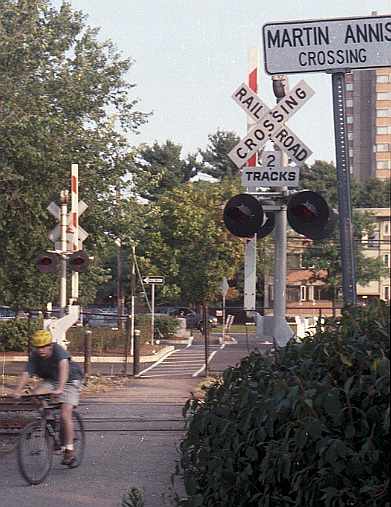
Top: Home Page
Up: Cambridge bicycle facilities and program
Previous:
Next:
A lightly-used railroad line separates the MIT campus in Cambridge, Massachusetts, USA
from the Cambridgeport residential and industrial areas. No street crosses the tracks for
many blocks, between Massachusetts Avenue and Memorial Drive. When I was a student at MIT
in the 1970s, there was also no formal crossing for bicyclists and pedestrians. People who
knew the neighborhood would walk across parking lots to cross the tracks. I had to lift
my bicycle over the tracks. Sometimes the tracks were blocked by strings of parked
railroad cars. The crossing is a real improvement -- butMore recently, a gated crossing has been created. The Martin Annis crossing is accessible on foot, or by bicycle or wheelchair. It represents a major improvement in access between the MIT campus and Cambridgeport. The crossing encourages bicycle and pedestrian travel by providing a shorter route than is possible using a motor vehicle. The Annis Crossing is mentioned on an MIT Web page, with the words:
These changes have already been made. The connection between the crossing and Vassar Street originally ran along the back and side of the parking lot. Most cyclists and pedestrians proceeded directly across the parking lot instead. The new connection is more direct. The Cambridgeport end of the Annis crossing is at Washington Park. This is the location of one of the cannon emplacements used during the siege of Boston in the American Revolution. This historic site was once almost forgotten and inaccessible. The Annis Crossing, along with street improvements and renovation of the district around the park, provides improved visibility and access. |
Looking across Annis Crossing toward Vassar Street
from Washington Park

| The paths around the park are surfaced in stone dust and brick. They do not meet modern design standards for bicycle facilities. This shortcoming is understandable, as the paths predate the installation of the crossing and were not originally intended for bicycle use. The curved perimeter of the park keeps the sight distance around the park reasonably long.. Sight obstructions posed by the bushes in the photo below should be corrected. |
Washington Park entrance to Annis Crossing
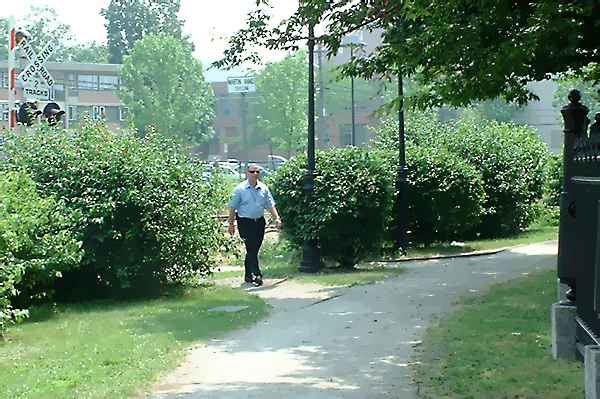
-- but the "improved" connection to Vassar Street
|
Annis Crossing connection to Vassar Street
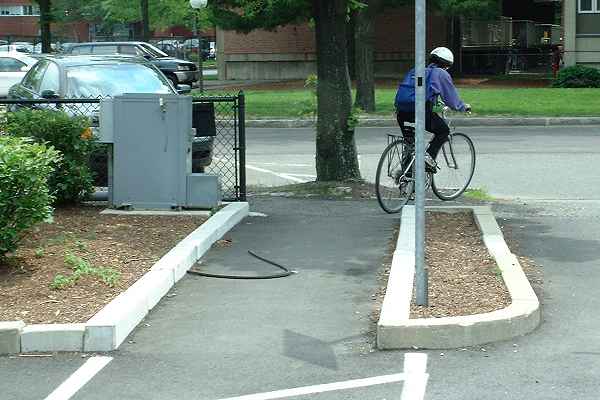
| The channel between the raised curbs is only wide enough for a one-way shared-use path
according to the AASHTO Guide. The curbs also defy AASHTO, as a bicyclist who strays into
one of them will topple over. AASHTO specifies rideable shoulders. The path heads directly for a tree. To exit the path, the bicyclist in the photo has turned sharply to the right. Turning to the left would require riding over tree roots and down a curb. The bicyclist in the photo is in head-on conflict with bicycle and motor traffic which might be entering the parking lot. Some of this traffic comes from the left, where it is concealed by parked cars. Now let's look at the same scene from the opposite direction. In the photo below, the large American flag that flies over Washington Park is at the upper left. The designated pathway runs from the railroad crossing at the center of the photo to the tree at the lower right. Motorists enter the parking lot via the gate at the middle left of the photo. Most of them turn right across the crosswalk after passing through the gate. The diamond-shaped, yellow pedestrian warning sign in the photo is intended to alert motorists to the traffic on the path. Its height and odd angle make it difficult for motorists to see as they turn into the driveway and wait for the gate to open. The height is probably intended to prevent motor vehicles or bicyclists from striking the sign -- Still, the signpost could still easily catch on the handlebar of a bicycle on the path.Warning markings on the pavement or the gate would make more sense. The pedestrians in the photo are not using the marked crosswalk. They are following their desire line toward the vehicular exit gate, to continue west on Vassar Street. |
Annis Crossing viewed from Vassar Street

| There is a sign on the fence at the lower right corner of the photo above. Here's a closer look at that sign: |
Sign at entrance to path from Vassar Street sidewalk
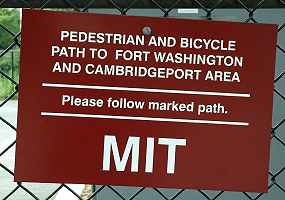
| Pedestrians ignore this sign, as we have already seen. Cyclists entering from Vassar Street can not easily negotiate the sharp turns to get onto the start of the path, and so they ignore this sign. They also ignore small signs on the gates reading "for automotive traffic only". The cyclists typically thread their way past the end of the entry gate, as shown in the photo below. |
Cyclist entering parking lot from Vassar Street
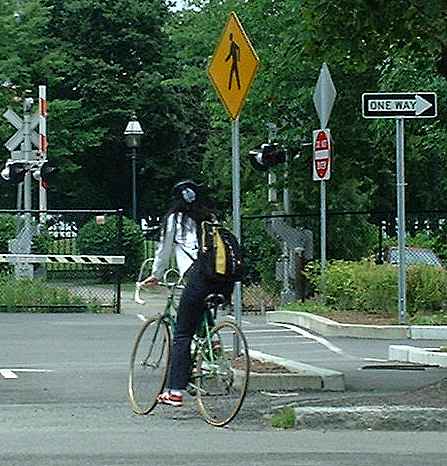
A cyclist entering the parking lot via the path instead of the gate is in conflict
with a motor vehicle entering the driveway and turning right. The motorist has to look
back and to the right, where many vehicles have a blind spot and at the same time look
ahead for traffic in the parking lot. Overall evaluationThe crossing of the railroad tracks is a standard design and is entirely acceptable. It may even be unusually cautious considering the small amount of slow rail traffic. The paths in Washington Park do not conform to AASHTO standards, but again, they predate the design of the crossing itself. Issues of historical preservation and funding may have put these paths outside the scope of the project. Bushes between the park and the railroad line create a hazardous sight obstruction which could be corrected easily by keeping them trimmed. The crosswalk and the path in the MIT parking lot violate numerous principles of bicycle facilities design. What to do?The fundamental problem with this project is the incorrect assumption that bicyclists should be treated as pedestrians and "protected" from motor vehicles by placing them on pedestrain-type facilities. Bicycles have the operating characteristics of vehicles, not of pedestrians. Bicyclists integrate much better into motor vehicle traffic than into pedestrian traffic, and they travel more safely along vehicular travel lanes than across them. In a parking lot where motor vehicles travel at bicycle speeds, bicyclists mix even better with motor traffic than elsewhere. Because the mixed bicycle-pedestrian facility that has been provided is of poor and substandard design, it poses a liability risk to MIT and casts an embarrassing light on MIT's reputation as an engineering institution. Bicyclists should be directed to enter and leave the parking lot by the driveways. The gates at the driveways could very easily be shortened so that there is room for bicyclists to pass around them easily. The sign at the entrance to the path should be changed to indicate that the path is for pedestrians. The warning sign should be replaced by one on the driveway gate, or by markings on the pavement. Improvements to the paths in Washington Park would also be desirable. A simple improvement that would require no additional funding would be to trim vegetation to improve sight lines. |
Top: Home Page
Up: Cambridge bicycle facilities and program
Previous:
Next: